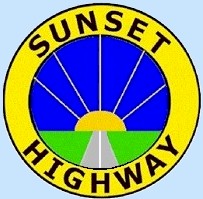
The Historic Sunset Highway
in Washington
Coulee City

The Historic Sunset Highway
in Washington
Coulee City
Coulee City
Before the settlers came to Coulee City, this was part of a major Indian Trail across the state. In the 1820's, the Hudson's Bay Company used this crossing to get supplies and furs between Fort Walla Walla and Fort Okanogan. In 1880, Lt. Symon's built a Military Road between Ritzville and Camp Chelan that came through here.
The first settlers in the Coulee City area were ranchers, Dan Paul and Philip McEntree, who drove cattle to the middle coulee crossing sometime in 1882. McEntree decided to settle there in 1883 and Paul came back and settled in 1886.
Coulee City has been used as the middle crossing of the Grand Coulee for thousands of years. After McEntree built a cabin, the place became known as McEntree’s Crossing of the Grand Coulee. The post office was established in 1888 and George R. Roberts who owned a store there, became the first postmaster.
In the Spring of 1890, the Central Washington Railroad finally made it to Coulee City and the town became its terminus. McEntree’s Crossing was officially named Coulee City. The railroad completed the line a little over a mile west of town and the grade was built for about 8 miles beyond the end of track, almost to the top of the “wall.” Now all the traffic and freight coming from the Columbia River, Wenatchee, Orondo, Waterville and Chelan only had to drive as far as Coulee City to meet the railroad.
Going up the “Wall” to “Pilot Rock” from the bottom is a climb of 8 miles and involved a series of loops, slants and switchbacks, The settlers called it “Haystack Rock”, because the rocks from a great distance look like haystacks.
There is a story about a newcomer from the east, who was riding through the Big Bend and commented on the quantity of hay that was being raised in this country after seeing the huge stacks of hay they made. “‘Where?” said the guide. “Why, right over there in that field,” said the newcomer, pointing to Pilot Rock. “Them’s rocks” said the guide…. Quiet ensued.
The people of Coulee City would look up at the “wall” as they called it, and watch the stage coaches as they rumbled down the hill. It was quite a sight as the stage swung down the winding, double, twisting road down to the town at the bottom. The drivers would be yelling at the horses and you could hear the cracking of the whips. The passengers would be hanging on for dear life, either in enjoyment or fear. The stages would first come into sight as a mere speck at the top of the hill miles away, and during the summer months, they would be surrounded by a cloud of dust.